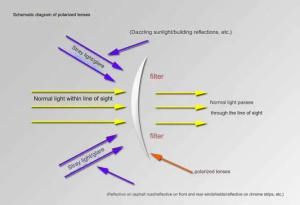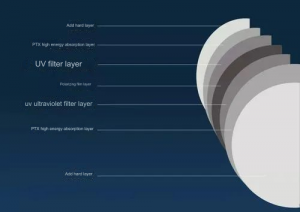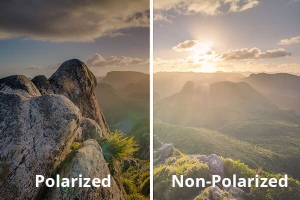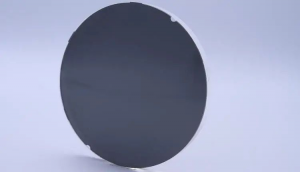When the weather is hot, more and more people choose to wear sunglasses to protect their eyes. Mainstream sunglasses are divided into tinted and polarized. Whether it is consumers or businesses, polarized sunglasses are not unfamiliar.
Definition Of Polarization
Polarization, also known as polarized light, refers to visible light being a transverse wave, with its vibration direction perpendicular to the direction of propagation. The vibration direction of natural light is arbitrary in the plane perpendicular to the direction of propagation; for polarized light, its vibration direction is limited to a specific direction at a certain moment.

Polarization Classification
Polarization can be divided into three types: linear polarization, elliptical polarization, and circular polarization. Generally, the so-called polarization refers to linear polarization, also known as plane polarization. The vibration of this type of light wave is fixed along a specific direction and remains unchanged. Its propagation path in space follows a sinusoidal curve, and its projection on the plane perpendicular to the direction of propagation is a straight line.

The plane formed by the vibration direction of linearly polarized light and the direction of propagation is called the plane of vibration, and the plane perpendicular to the vibration direction and containing the direction of propagation is called the plane of polarization. Passing natural light through a polarizer can produce linearly polarized light.
The Function Of Polarization
In daily life, there are many light sources that produce harmful light, especially sunlight. Sunlight emits three types of light: visible light, infrared light, and ultraviolet (UV) light. Among these, ultraviolet light can cause serious harm to the skin and eyes. Visible light ranges from 380 to 780 nanometers, while ultraviolet light is further divided into UVA, UVB, and UVC, with wavelengths above 310nm. UVA, UVB, and UVC are harmful rays. Prolonged exposure to these rays can cause damage to the body. UVB has a serious impact on vision, and it is also the "tanning ray" that darkens the skin. Most of the eye's corners absorb this type of UVB light, so it is essential to block this light source.
Polarized lenses have the function of polarizing light, which allows them to block harmful light without affecting the transmission of visible light, thereby protecting the eyes. In addition to the basic function of UV protection, polarized lenses also have anti-glare, road reflection, and water surface glare functions, making them suitable for driving, fishing, travel, and daily wear.
The Production Of Polarized Lenses
In layman's terms, polarized lenses for nearsightedness have a sandwich-like structure (consisting of a front layer of sunglasses, a middle layer of polarized fibers, and a back layer of nearsighted lenses, all laminated together). The commonly used lens material has a refractive index of 1.50 (there are also 1.60, but they are more expensive). The lenses are relatively thick and heavy, and if the prescription exceeds 600°, both the aesthetics and comfort will be significantly affected. The price range of polarized lenses for nearsightedness is quite wide and depends on the production manufacturer's process stability and quality.
Polarized lenses are helpful in filtering out some scattered light (such as the grating effect of blinds), but there is a significant difference in quality. Poor-quality polarized lenses are prone to delamination and cracking, and many do not meet optical standards.
The Materials Of Polarized Lenses
There are four common types of polarized lenses on the market: glass lenses, resin lenses, PC lenses, and TAC lenses.
① Glass lenses
Although they are scratch-resistant and have good optical performance, their weight and safety issues have led to a gradual decrease in their use.
② Resin lenses
They are easy to tint, lightweight, and impact-resistant, making them one of the mainstream materials for popular sunglasses. However, resin lenses are prone to chipping during the edging process, and they can still pose safety hazards when subjected to significant impact.
③ TAC lenses
TAC is one of the transparent high molecular materials. TAC lenses as sunglasses have features such as acid and alkali resistance, lightweight, and high cost-effectiveness. However, TAC lenses have poor abrasion resistance and unstable optical characteristics. Despite their low price, they have been abandoned by the majority of well-known foreign brands.
④ PC lenses
They are lightweight, have good tinting performance, and stronger impact resistance, which also makes them relatively expensive.
PC lenses overcome the spherical stress and astigmatism problems caused by the deformation of traditional TAC lenses after being framed. They have very strong impact resistance (60 times that of glass lenses, 20 times that of TAC lenses, and 10 times that of resin lenses) and are widely used in aerospace and military fields. At the same time, PC lenses are lightweight, being 37% lighter than the more common resin lenses.
The Distinction Between Polarized Lenses And Tinted Lenses
Tinted lenses only utilize the function of reducing light, and they cannot filter out light. They can only reduce the intensity of glare, ultraviolet light, etc., and cannot completely block these harmful light rays. At the same time, because of the reduced light, it affects the transmittance of the lenses, posing a safety hazard for wearers.
Post time: Dec-29-2023




